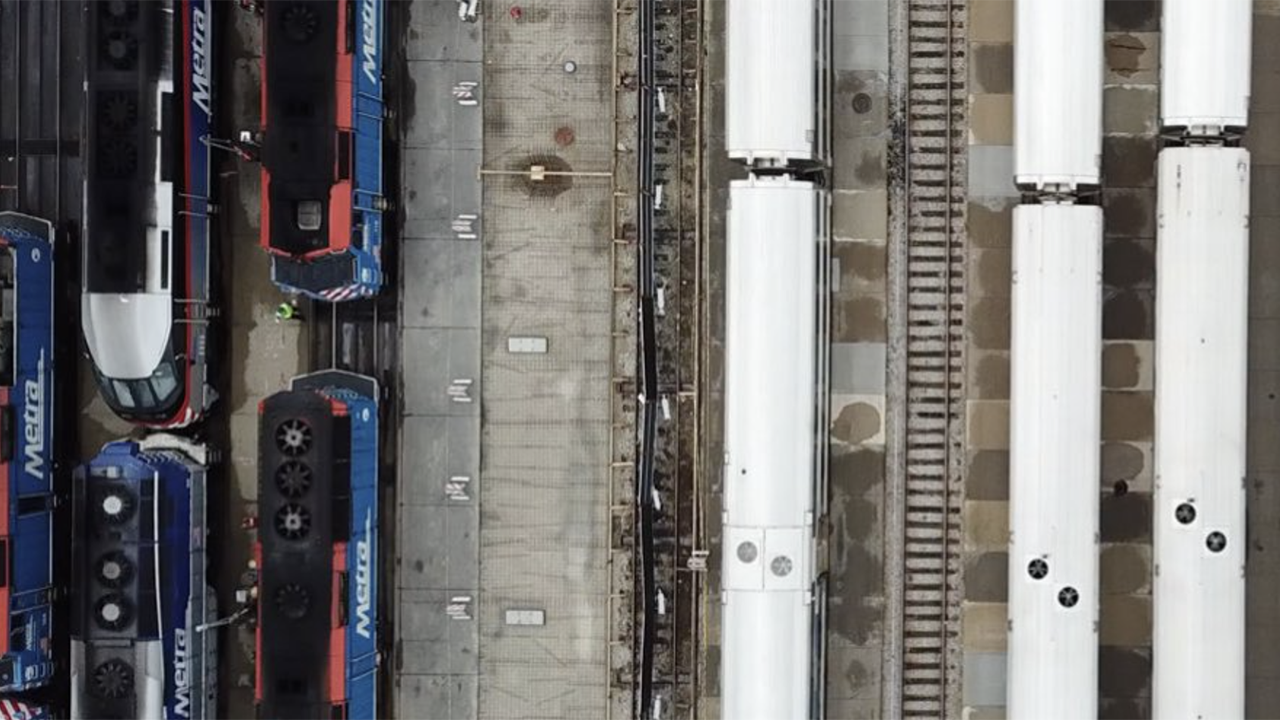
Transit Briefs: Metra, NYMTA, City of West Palm Beach, MBTA
Written by Marybeth Luczak, Executive Editor
Illinois State Sen. Ram Villivalam (D-Chicago) and Rep. Eva-Dina Delgado (D-Chicago) have introduced the Metropolitan Mobility Authority Act that seeks to combine RTA, CTA, Metra and Pace into a new Chicagoland entity and provide it with a $1.5 billion annual boost, according to a WGN9 report on April 29. (Metra Photograph)
Chicago’s Metra speaks out on the Metropolitan Mobility Authority Act that proposes merging the commuter railroad, Chicago Transit Authority (CTA), Pace bus, and Regional Transit Authority (RTA). Also, New York Metropolitan Transportation Authority (MTA) outlines its nearly $300 million in capital program savings; City of West Palm Beach, Fla., adopts a “Rail S.A.F.E.” policy, aiming for zero railway fatalities; and Massachusetts Bay Transportation Authority (MBTA) weighs Haverhill station shutdown during bridge replacement project.
Metra
Illinois State Sen. Ram Villivalam (D-Chicago) and Rep. Eva-Dina Delgado (D-Chicago) have introduced the Metropolitan Mobility Authority Act that seeks to combine RTA, CTA, Metra and Pace into a new Chicagoland entity and provide it with a $1.5 billion annual boost, according to a WGN9 report on April 29.
The move “aims to streamline services and reduce the competition for funding,” as the agencies face a $730 million budget gap once COVID funding expires by 2026, and it follows last year’s Chicago Metropolitan Agency for Planning report that recommended the consolidation and other reforms, the media outlet said.
“Governance of the new body would be in the form of nearly 20 voting members, down from the nearly 50 split between the current agencies,” WGN9 reported. “Three members would be appointed by the governor. The mayor of Chicago and president of the Cook County Board would appoint five each. One member would be appointed by each of the county executives of DuPage, Kane, Lake, McHenry and Will counties. A chair would be chosen from the members but would not be someone from the group.
“Another six non-voting members would join the board: the secretary of the Illinois Department of Transportation, the chair of the Illinois Tollway, an organized labor representative chosen by the governor, the chair of the agency’s citizen advisory board and a representative each for the business and disabled communities, chosen by the board.”

Metra on May 7 released the following statement on the Metropolitan Mobility Authority Act proposal:
“Metra applauds Senator Ram Villivalam and Representative Eva-Dina Delgado for their leadership in Springfield and for starting the conversation about the future of public transportation in northeast Illinois in the wake of COVID-19 pandemic. We share the view that this is an opportunity to improve public transportation for this and future generations.
“We all have the same goals to be the best in the nation when it comes to transit. Public transportation has long played an essential role in the regional economy, providing residents with safe, fast, affordable, and reliable connections to jobs, schools, friends, families, and much more. We all recognize the need for a thriving, efficient and effective system and we will all strive for a solution that preserves and improves transportation’s essential role.
“Before, during and after the pandemic, Metra and its dedicated, professional workforce did its part. During its nearly 40-year history, Metra earned a well-deserved reputation for providing world-class service to the six-county area, while being a wise and responsible steward of funding from its riders and regional taxpayers.
“However, Metra is facing a fiscal cliff in 2026, just like its sister agencies in the region, CTA, and Pace, and like other transit agencies across the country from California, New York, Pennsylvania, and even in our nation’s capital—Washington, D.C. Some peer agencies are facing a fiscal cliff even sooner. It is caused by the pandemic-related changes to work patterns and commutes, which appear to be permanent. And it cannot be solved with fare increases and/or service cuts without devastating, counterproductive consequences.
“Metra responded responsibly to the pandemic, taking steps that protected public health and its bottom line while providing critical service for essential workers and responding to the changing needs of its riders. It cut service when ridership plummeted but immediately adopted service restoration principles that prioritized consistent, frequent trains, memorable service patterns, new express service, transfers, reverse commutes, and regional equity.
“Metra put those principles in action with new schedules on most lines. It also adopted a new strategic plan with a new vision for Metra—to provide fast, frequent service throughout the day, not just in rush periods. And even during the middle of the pandemic, it carried out a pilot reduced fare program with Cook County that promoted equity in disadvantaged communities. We are one of the first in the nation to do so.

“And Metra has taken a variety of other recent steps that demonstrate its commitment to its riders and to fiscal responsibility:
- “Launched a major initiative to rehabilitate and make accessible more than a dozen stations on the Metra Electric Line.
- “Ordered at least 200 state-of-the-art, multilevel cars that will be more comfortable, accessible, reliable, and safe than the outdated gallery cars they will replace.
- “Ordered eight two-car, battery-powered/zero emission trainsets, making Metra one of the first agencies in the nation to pursue this innovative technology.
- “Ordered and began taking delivery of 24 remanufactured SD70-MACH locomotives, which will significantly increase reliability and decrease pollution.
- “Adopted a major revision to its fare structure that customers can easily understand, that encourages ridership, simplifies onboard fare collection, and meets Metra’s financial and technical constraints.
- “Created a new customer service training program and a new Customer Response Team to provide riders with top-notch customer service.
- “Installed new, easy-to-use ticket vending machines at major stations, with a goal of installing them in every station over the next few years.
- “Launched a new train-tracker that provides riders with the most up-to-date train arrival and schedule information.
- “Installed new passenger information signs at numerous stations that provide information from the train-tracking system.
- “Implemented a new policy, facilitated by the installation of new racks on dozens of railcars, to allow bikes on every train.
- “Started a new pilot program with Cook County and RTA to provide reduced fare rates to low-income riders.
- “Started a new pilot program with the University of Illinois at Chicago to provide reduced fare rates to its students.
- “Agreed to work with IDOT to provide new rail service between Chicago and Rockford.
- “Continued its in-house railcar and locomotive rehab programs, saving Metra $172.2 million to date versus outsourcing and keeping jobs and dollars in Illinois and Chicago.
- “Started a major Diversity, Equity, and Inclusion initiative.
- “Carried out well-received initiatives such as Holiday Trains, Earth Day cleanup, special weekend service on the Heritage Corridor, Toys for Tots drive and more.
- “Carried out numerous marketing initiatives that promoted Metra as the safest, most affordable, and most reliable travel option.

“Metra is grateful for the generous aid it has received from federal, state, and local sources throughout its history and especially during and since the pandemic.
“We deeply appreciate all of the work by the President, our congressional delegation, the Governor, and the Illinois General Assembly, for their strong support for public transportation and our riders through the region.
“Metra stands ready to continue its work on behalf of regional riders and taxpayers. We want to be transparent; we want to listen to all stakeholders to address our funding issues; and we want to be part of the conversation to create the best possible public transportation system for the region.”
MTA
MTA Construction & Development (C&D) on May 7 provided details on its nearly $300 million in capital program cost savings as part of a 2023 Year in Review and 2024 Strategic Plan (see above), which outlines initiatives to improve the delivery of capital projects—such a new delivery models and project bundling—and to modernize the transit system “better, faster, and cheaper.” According to MTA, the report comes as the agency prepares to move forward on a major slate of capital projects to be funded by congestion pricing. In addition to reducing traffic and improving air quality, the agency said, congestion pricing is the source of $15 billion for transit and commuter rail projects, representing 30% of the total 2020-2024 Program, and more than 50% of remaining projects in the program. This funding is expected to pay for reliability, accessibility, sustainability, and state of good repair projects throughout the entire transit system.
In 2023, MTA completed more than $7 billion in capital projects, which was said to be the highest in MTA history. Additionally, it awarded more than $8 billion in new commitments, with those awards coming in 6.2% below the engineer’s estimate, saving nearly $300 million, the agency reported.
Among MTA’s completed projects are:
- Canarsie L Tunnel rehabilitation phase “completed ahead of schedule and under budget.”
- Resiliency upgrades at the Coney Island Yard, “completed on budget.”
- LIRR Third Track “completed on time and $100 million under budget.”
- LIRR Penn Station 33rd Street Concourse “completed on time and under budget.”
- 28 projects completed since 2020 to make stations accessible to all under the Americas with Disabilities Act.
- On-time delivery of major projects that “bring MTA infrastructure into a state of good repair,” including tunnel and infrastructure renewal on the Concourse B D Line tunnel in the Bronx and a project to upgrade track on the 63rd Street Tunnel under the East River used by the F subway line.
The report also provides an update on the recommendations put forward by the consultant firm Crowe, which performed a forensic evaluation of the MTA’s capital planning process in 2019. Since this audit, which coincided with the creation of MTA C&D as a new unified capital delivery agency, MTA said it has doubled down on cost containment, with 90% of 2020-2024 capital projects costs within budget. MTA reported that it has also reduced project schedules by an average of four months and accelerated the scale of work in construction, tripling the number of accessibility upgrade projects underway, for example.
“In addition to managing projects efficiently, these changes have transformed the long-term planning process,” MTA said. “The 20-Year Needs Assessment released last year was the most comprehensive in MTA history, evaluating nearly 6 million assets across the entire MTA system. It laid out in detail the urgent need for continued investment and set the stage for the creation of the 2025-2029 Capital Program as the MTA continues to meet the transit system’s needs.”
Commented MTA Construction & Development President Jamie Torres-Springer: “This Strategic Plan catalogs the progress we’ve made in the few short years since Construction & Development was created and lays out a plan to accelerate it going forward.”
For more on Manhattan congestion pricing, click here.
City of West Palm Beach

The City of West Palm Beach on May 7 announced its adoption of the “Rail S.A.F.E.” (Safety And Functionality for Everyone) policy resolution, establishing what it called an “ambitious goal of zero fatalities and reducing serious injuries from trespassing on railroad rights-of-way or crashes involving trains, vehicles, bicyclists, and pedestrians.”
“With our growing population of more than 117,000 residents, coupled with the influx of tens of thousands of daily visitors and 8.4 million annual transit riders, ensuring rail safety is vital for West Palm Beach,” Mayor Keith A. James said. “The Rail S.A.F.E. policy formalizes our commitment to making our rail corridors as safe as possible through a comprehensive approach of equitable engineering, education, enforcement and data-driven initiatives.”
According to the City, this “first-of-its-kind policy for the region” considers rail safety within the context of the City and the region’s entire transportation network. It mandates implementing multiple layers of protection like road design standards, infrastructure improvements, public engagement, and policy changes to prevent rail trespassing and vehicle-train collisions. The policy, it noted, builds on West Palm Beach’s 2014 trespass prevention study, safety awareness initiatives, quiet zone expansions, and comprehensive 2024 rail crossing safety audit.
The City said that the development of a detailed “Keep It Rail S.A.F.E.” Action Plan would come next “to eliminate fatalities and serious injuries through engineering solutions, education campaigns, enforcement efforts, and comprehensive community planning.”
“As rail transit expands across South Florida, West Palm Beach’s Rail S.A.F.E. policy positions the City as a pioneering model for proactive rail safety policies and measures,” the City said. “This priority aims to foster a safer, more reliable rail system that encourages residents and visitors to utilize trains, walking, biking, and public transit.”
Further Reading:
MBTA

Commuter rail service to Haverhill’s downtown station could be paused completely or partially during the year-long installation of a new rail bridge in Bradford, Mass., The Eagle-Tribune of North Andover, Mass., reported May 6. The Amtrak Downeaster would be able to stop there however, and CSX freight service would continue to pass through, it said.
MBTA is slated to make a decision in a week, according to the newspaper.
Josselyn De León-Estrada, Mayor Melinda Barrett’s Deputy Chief of Staff, “said the mayor and the city’s legislative delegation understand the need to replace the train bridge but the city wants the MBTA to minimize the impact on commuters as well as residents who may have to deal with traffic issues,” the newspaper reported. “She said the MBTA runs about 25 commuter trains a day compared to 10 for Amtrak and six to eight for CSX. De León-Estrada said the mayor requested continued service to the Haverhill station but if the rail can’t operate as normal to provide commuter trains during peak hours.” She noted that if that was not possible, the group has asked MBTA to offer bus service between the Haverhill and Bradford stations.



